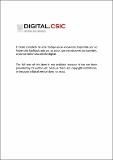Por favor, use este identificador para citar o enlazar a este item:
http://hdl.handle.net/10261/332343COMPARTIR / EXPORTAR:
 SHARE
BASE SHARE
BASE
|
|
| Visualizar otros formatos: MARC | Dublin Core | RDF | ORE | MODS | METS | DIDL | DATACITE | |

| Título: | Supporting Information for Adv. Funct. Mater., DOI: 10.1002/adfm.202200529 Enhanced Polysulfide Conversion with Highly Conductive and Electrocatalytic Iodine-Doped Bismuth Selenide Nanosheets in Lithium–Sulfur Batteries |
Autor: | Li, Mengyao; Yang, Dawei; Jacas Biendicho, Jordi; Han, Xu CSIC ORCID; Zhang, Chaoqi; Liu, Kun; Diao, Jiefeng; Li, Junshan; Wang, Jing; Heggen, Marc; Dunin-Borkowski, Rafal E.; Wang, Jiaao; Henkelman, Graeme; Morante, Joan Ramón CSIC ORCID; Arbiol, Jordi CSIC ORCID CVN; Chou, Shu-Lei; Cabot, Andreu | Fecha de publicación: | 24-jun-2022 | Editor: | Wiley-VCH | Citación: | Li, Mengyao; Yang, Dawei; Jacas Biendicho, Jordi; Han, Xu; Zhang, Chaoqi; Liu, Kun; Diao, Jiefeng; Li, Junshan; Wang, Jing; Heggen, Marc; Dunin-Borkowski, Rafal E.; Wang, Jiaao; Henkelman, Graeme; Morante, Joan Ramón; Arbiol, Jordi; Chou, Shu-Lei; Cabot, Andreu; 2022; Supporting Information for Adv. Funct. Mater., DOI: 10.1002/adfm.202200529 Enhanced Polysulfide Conversion with Highly Conductive and Electrocatalytic Iodine-Doped Bismuth Selenide Nanosheets in Lithium–Sulfur Batteries [Dataset]; Wiley-VCH; https://doi.org/10.1002/adfm.202200529 | Descripción: | 14 pages. -- PDF file includes: Details of Theoretical calculations. -- Figure S1. (a) SEM images of the Bi2Se3 nanosheets. (b) XRD patterns of Bi2Se3 nanosheets. (c) HRTEM images of the Bi2Se3 nanosheets and its corresponding power spectrum. (d) EELS chemical composition maps obtained from the red squared area of the STEM micrograph. -- Figure S2. Bi 4f and Se 3d high-resolution XPS spectra. -- Figure S3. XRD pattern of I-Bi2Se3/S. -- Figure S4. TGA curve of I-Bi2Se3/S composite measured in N2 with a sulfur loading ratio of 70.2 wt%. -- Figure S5. Nitrogen adsorption-desorption isotherms of as synthesized I-Bi2Se3 and IBi2Se3/S composites. -- Figure S6. DFT calculation results of optimized geometrical configurations of the surface (110) of Bi2Se3 with LiPS (Li2S, Li2S2, Li2S4, Li2S6, Li2S8 and S8). -- Figure S7. DFT calculation results of optimized geometrical configurations of the surface (110) of I-Bi2Se3 with LiPS (Li2S, Li2S2, Li2S4, Li2S6, Li2S8 and S8). -- Figure S8. Optimized adsorption configuration of Li2S decomposition on Bi2Se3. -- Figure S9. First five cycles of CV curves of (a) I-Bi2Se3/S, (b) Bi2Se3/S and (c) Super P/S performed at a scan rate of 0.1 mV s−1. -- Figure S10. Differential CV curves of (a) I-Bi2Se3/S, (c) Bi2Se3/S and (e) Super P/S. The baseline voltage and current density are defined as the value before the redox peak, where the variation on current density is the smallest, named as dI/dV=0. -- Figure S11. CV curves of (a) Bi2Se3/S, (b) Super P/S and (c) Plot of CV peak current for peaks C1, C2, and A versus the square root of the scan rates. -- Figure S12. The CV curve of I-Bi2Se3 as electrode measured in symmetric coin cell using an electrolyte without Li2S6. -- Figure S13. (a) Charge, and (b) discharge profiles of I-Bi2Se3/S, Bi2Se3/S, and Super P/S electrodes showing the overpotentials for conversion between soluble LiPS and insoluble Li2S2/Li2S. -- Figure S14. Galvanostatic charge−discharge profiles of (a) Bi2Se3/S and (b) Super P/S at different current densities range from 0.1C to 4C. -- Figure S15. (a,b) EIS spectra of (a) Bi2Se3/S and (b) Super P/S coin cells before and after cycling. The solid line corresponding to the fitting result from the equivalent circuit (c) and (d), and the Rs, Rin, Rct, and Zw stand for the resistance of the electrolyte, insoluble Li2S2/Li2S layer, interfacial charge-transportation, and semi-infinite Warburg diffusion, respectively; and CPE stands for the corresponding capacitance. (e) Different resistances of three coin cells were obtained from the equivalent circuit. -- Figure S16. XRD patterns of electrode materials after 100 cycles at 1C. -- Figure S17. Galvanostatic charge/discharge profiles of I-Bi2Se3/S at 0.5C under a lean electrolyte condition with a high sulfur loading of 5.2 mg cm-2. -- Figure S18. (a) SEM image of the Li-anode after cycling; (b) EDX mapping image of Lianode showing sulfur signal after cycling. -- Figure S19. SEM image of the cathode material after cycling, EDX spectra and EDX elemental maps for S, Se, Bi and I. -- Figure S20. I-Bi2Se3 optimized configuration as calculated by DFT. The distance between I and Bi is 3.15 Å, which is similar values than the bond lengths in bulk BiI3. -- Table S1 Summary of the comparison of I-Bi2Se3 electrochemical performance as host cathode for LSBs with state-of-the-art Bi-based or Se-based materials. | Versión del editor: | https://doi.org/10.1002/adfm.202200529 | URI: | http://hdl.handle.net/10261/332343 | DOI: | 10.1002/adfm.202200529 | Referencias: | Li, Mengyao; Yang, Dawei; Jacas Biendicho, Jordi; Han, Xu; Zhang, Chaoqi; Liu, Kun; Diao, Jiefeng; Li, Junshan; Wang, Jing; Heggen, Marc; Dunin-Borkowski, Rafal E.; Wang, Jiaao; Henkelman, Graeme; Morante, Joan Ramón; Arbiol, Jordi; Chou, Shu-Lei; Cabot, Andreu. Enhanced polysulfide conversion with highly conductive and electrocatalytic iodine-doped bismuth selenide nanosheets in lithium–sulfur batteries. https://doi.org/10.1002/adfm.202200529. http://hdl.handle.net/10261/287535 |
| Aparece en las colecciones: | (CIN2) Conjuntos de datos |
Ficheros en este ítem:
| Fichero | Descripción | Tamaño | Formato | |
|---|---|---|---|---|
| Acceso_restringido.pdf | 108,79 kB | Adobe PDF |  Visualizar/Abrir | |
| README.txt | 7,26 kB | Text | Visualizar/Abrir |
CORE Recommender
Page view(s)
45
checked on 07-may-2024
Download(s)
22
checked on 07-may-2024
Google ScholarTM
Check
Altmetric
Altmetric
NOTA: Los ítems de Digital.CSIC están protegidos por copyright, con todos los derechos reservados, a menos que se indique lo contrario.


